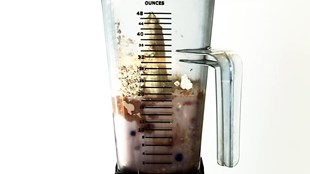What would you like for breakfast? Something green? A mixture of kale, spinach, and celery blended and served in a jam jar? Or something from the warmer side of the color spectrum – a concoction of carrot, beetroot, berries and turmeric root?
As you may have noticed, juices and smoothies comprised of unlikely combinations of fruit and vegetables (and other fashionable ingredients such as chia seeds and coconut water) are de rigueur. Increasingly they are being consumed not just as a drink or snack but as a total meal alternative – and not just for breakfast.
So, do they work?
Sometimes – but it depends. Not all juices and smoothies are created equal. Cold-pressed juices – in which the juice is extracted by crushing and pressing – don’t have the added sugars that bottled juices often contain, and you can get the nutritional benefits of a combination of fruit in one easy-to-swallow juice.
However, fruit contains fructose, a natural sugar, and it can be devilishly hard keeping track of the calories contained in an extract of apples, pineapple, mangoes and oranges.
Green juices, such as those made with kale and spinach, contain less sugar than their fruitier counterparts. But, like fruit juices, they won’t have the fiber you get from the whole food.
A blended drink, or smoothie, will contain more fiber than a juice, and you can add ingredients to it for extra fiber. But even then you can get too much of a good thing.
There’s increasing evidence that our brain isn’t as good at figuring out when we’ve had enough when we drink our food rather than eat it. You’ll feel fuller for longer after eating a couple of oranges than you will after drinking a juice or smoothie made from six of them.
It’s complicated, and the long-term impact of drinking our food rather than eating it is not well understood. Some nutritionists say chewing and digesting whole foods slows and stabilizes the entry of nutrients into the bloodstream. Others point out that we have teeth and the underlying bone structure that holds them in place for good reason – to chew our food. And, well, use it or lose it?
It’s also worth bearing in mind that our ancestors on the savannah didn’t have blenders and juicers. They drank water when they were thirsty and ate food when they could get it. Common sense would suggest we’re more physiologically equipped to monitor our energy intake in response to solid rather than liquid food.
There’s even been a suggestion that the sound of chewing, chomping and crunching our food (the researchers call it “the crunch effect”) helps us regulate how much we eat. To be fair, the researchers weren’t comparing the effect of drinking our food to eating it, but they did find that participants who wore headphones and listened to loud music while snacking tended to eat more. Underlying the study was the idea of mindfulness, that hearing ourselves eat helps us pay attention to what we’re eating, which helps keep our appetites in check. You could, of course, take a mindful approach to your smoothie – but how well can you hear yourself drink?
The fashion for smoothies and juices was explored in the BBC series, the Food Chain, in which Anne Murcott, an expert in sociology and food noted that humans have always ground up their food and mixed it with water – to make soup, for instance. Murcott saw a connection between the promotion of milk in the UK as a nutritional meal in a glass in the 1950s, and the promotion of juices and smoothies of today, and between the milk bars of the 50s and the juice bars of today.
What does this tell us? “It tells us about a very clever and very efficient food industry,” she said. That is, an industry skilled at harnessing consumer craving for novelty and creating a demand for things which, not so long ago, we didn’t think we needed.
As with most successful marketing campaigns, there is some myth-making involved. Marketers (and celebrities like Oprah and Gwyneth Paltrow) promote juices and smoothies as “cleansing”. But the body detoxifies itself naturally, thanks to our liver, kidneys and gastrointestinal tract. The best way to “cleanse” your digestive system (we used to say “keep things regular”) is to get plenty of fiber, which is best sourced from whole food.
Finally, while smoothies and juices may be a convenient, healthy, nutritionally-rich fast food for those who are too busy to sit down to a meal, but are we really so busy? Unless you’re extremely poor, mealtime isn’t just about the sustenance. It is a socially and culturally important ritual that, at the very least, provides punctuation to our days, a chance to down tools and take time out.
If you consider the psychological as well as the nutritional benefits of a meal, then you might just wonder, what’s the rush?






